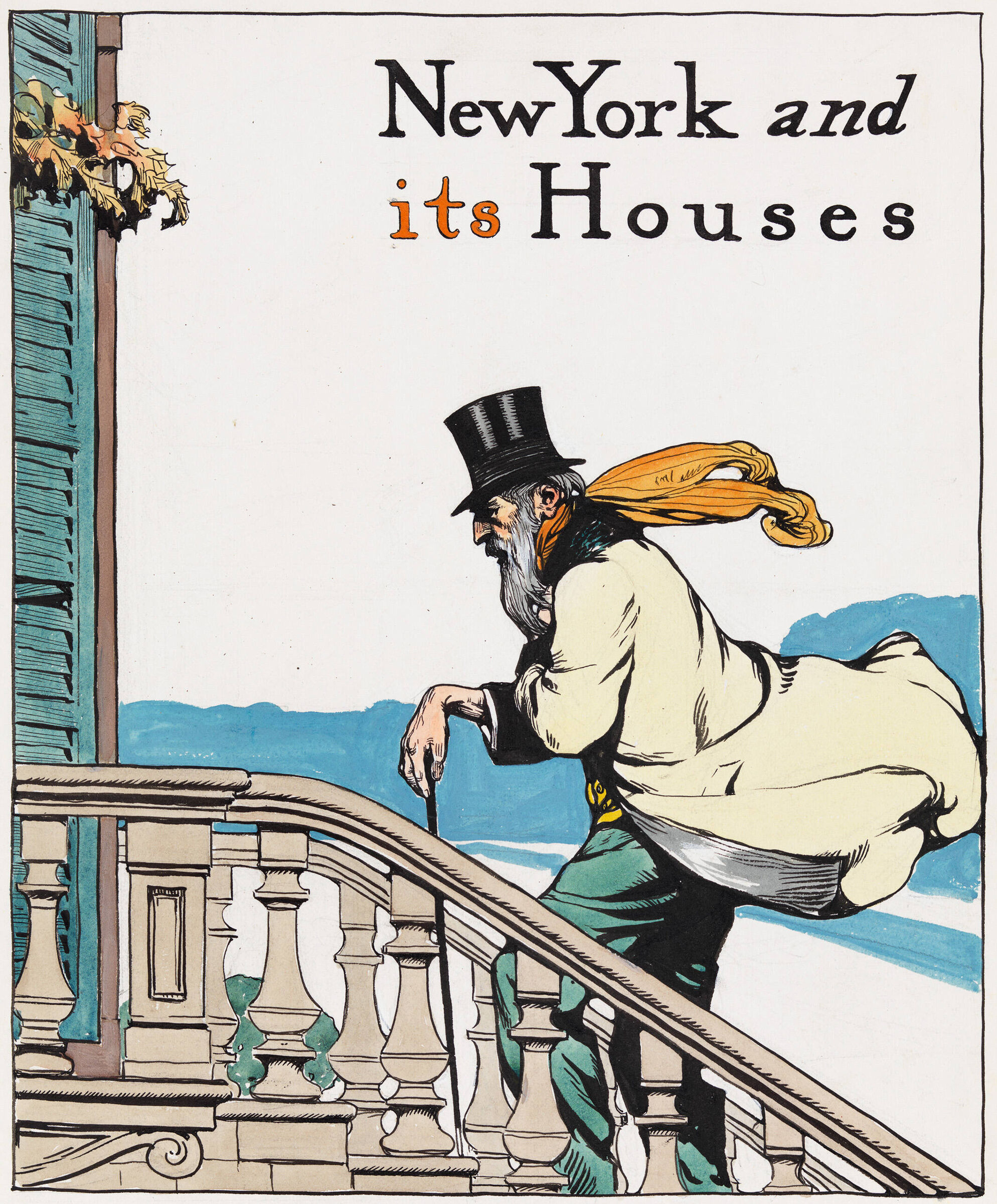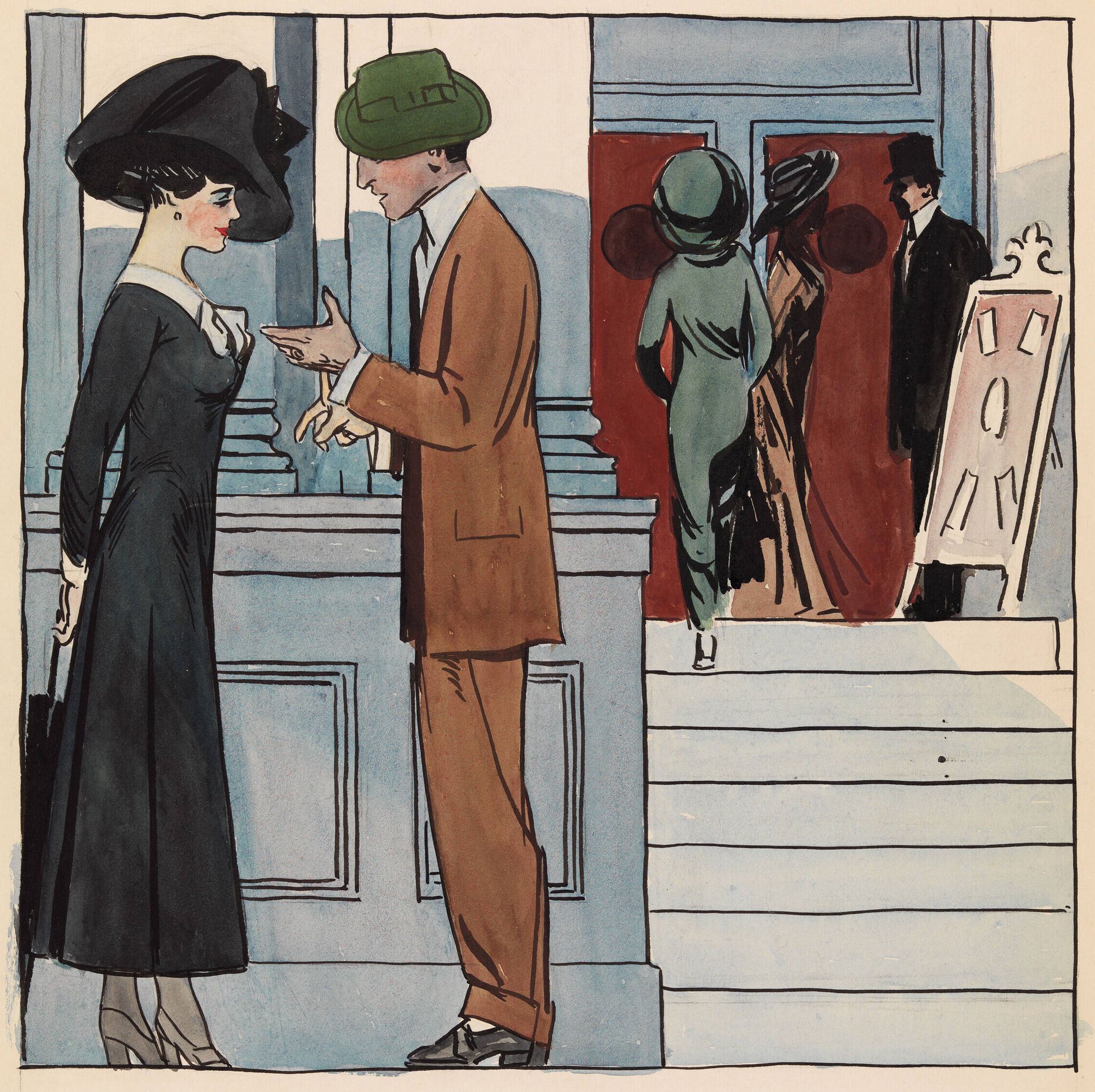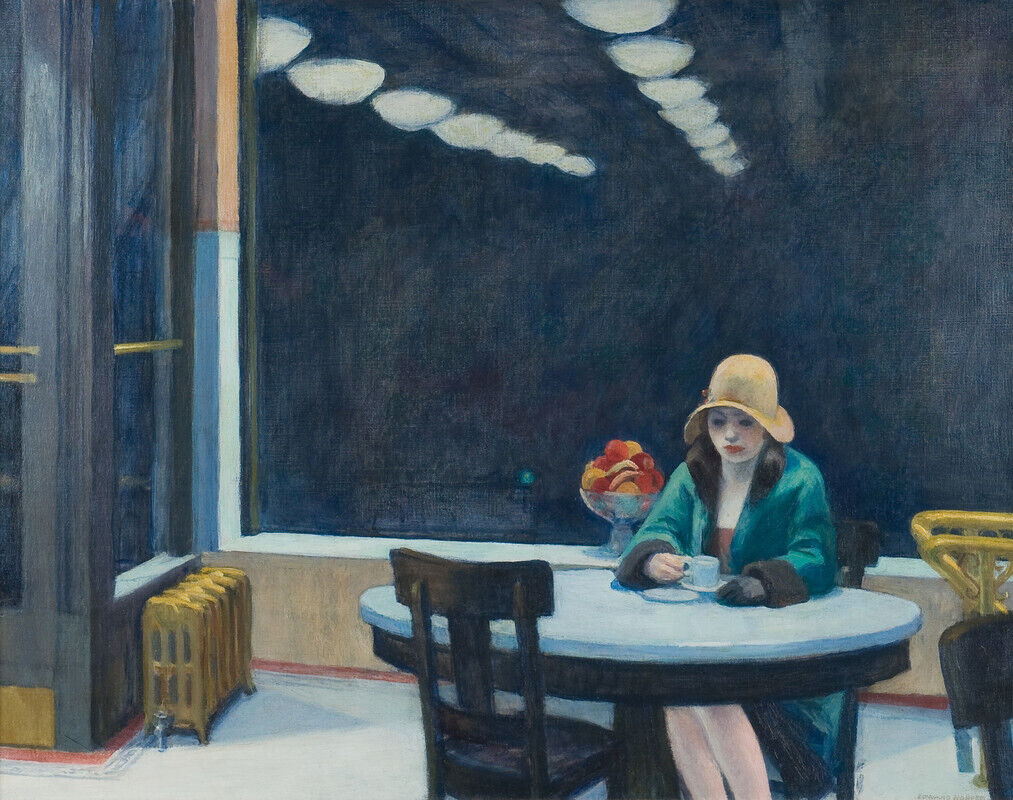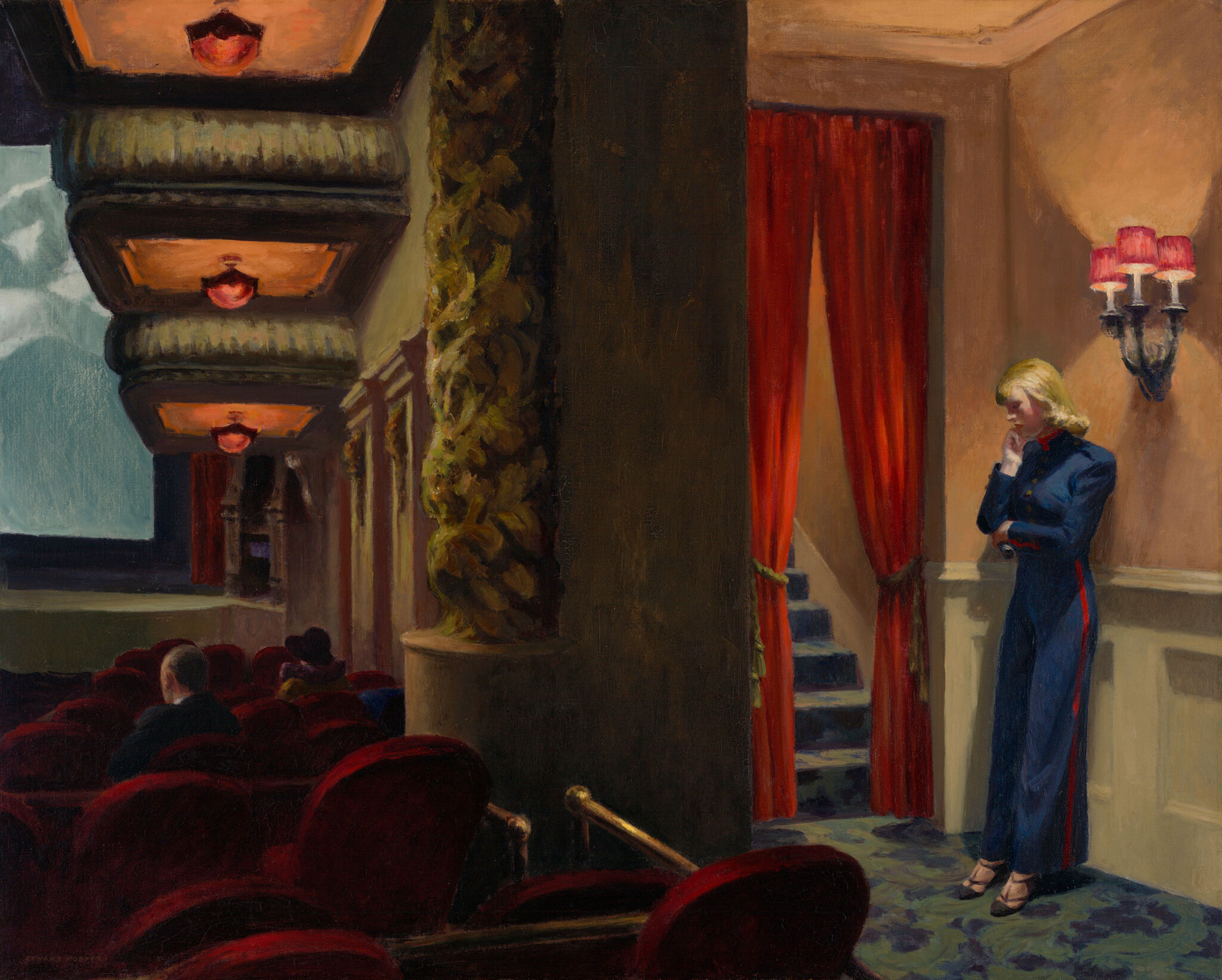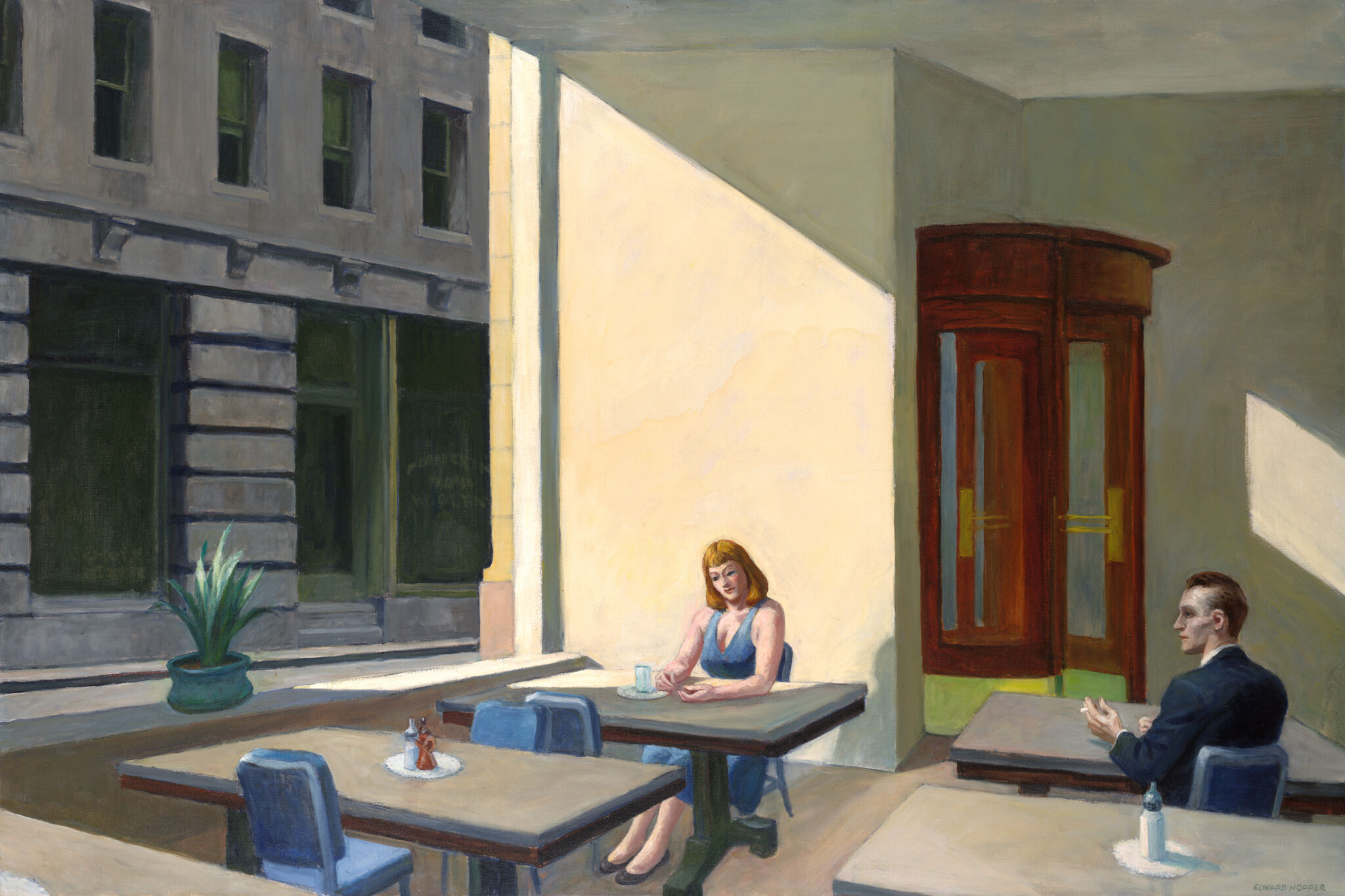Edward Hopper’s New York, on view at the Whitney Museum of American Art from October 19, 2022, through March 5, 2023, offers an unprecedented examination of Hopper’s life and work in the city that he called home for nearly six decades (1908–67). The exhibition charts the artist’s enduring fascination with the city through more than 200 paintings, watercolors, prints, and drawings from the Whitney’s preeminent collection of Hopper’s work, loans from public and private collections, and archival materials including printed ephemera, correspondence, photographs, and notebooks. From early sketches to paintings from late in his career, Edward Hopper’s New York reveals a vision of the metropolis that is as much a manifestation of Hopper himself as it is a record of a changing city, whose perpetual and sometimes tense reinvention feels particularly relevant today.
Instantly recognizable paintings featured in the exhibition, such as Automat (1927), Early Sunday Morning (1930), Room in New York (1932), New York Movie (1939), and Morning Sun (1952), are joined by lesser-known yet critically important compositions including a series of watercolors of New York rooftops and bridges and the painting City Roofs (1932).
“Edward Hopper’s New York offers a remarkable opportunity to celebrate an ever-changing yet timeless city through the work of an American icon,” says Adam D. Weinberg, the Alice Pratt Brown Director of the Whitney Museum. “As New York bounces back after two challenging years of global pandemic, this exhibition reconsiders the life and work of Edward Hopper, serves as a barometer of our times, and introduces a new generation of audiences to Hopper’s work by a new generation of scholars. This exhibition offers fresh perspectives and radical new insights.”
Edward Hopper’s New York is organized by Kim Conaty, Steven and Ann Ames Curator of Drawings and Prints, with Melinda Lang, Senior Curatorial Assistant, at the Whitney.
Edward Hopper and New York City
Born in the Hudson River town of Nyack, New York, in 1882, Hopper first visited Manhattan on family day trips. After completing high school, he commuted to the city by ferry to attend the New York School of Illustration and the New York School of Art. In 1908 he moved to the city, and he spent the majority of his life, from 1913 until his death in 1967, living and working in a top-floor apartment at 3 Washington Square North in Greenwich Village. He was joined there by his wife, the artist Josephine (Jo) Verstille Nivison, following their marriage in 1924. Jo played a crucial supportive and collaborative role in Hopper’s practice, serving as his longstanding model and chief record-keeper. A selection of Jo’s watercolors, capturing their Washington Square home, are included in Edward Hopper’s New York.
“Hopper lived most of his life right here, only blocks from where the Whitney stands today,” says Conaty. “He experienced the same streets and witnessed the incessant cycles of demolition and construction that continue today, as New York reinvents itself again and again. Yet, as few others have done so poignantly, Hopper captured a city that was both changing and changeless, a particular place in time and one distinctly shaped by his imagination. Seeing his work through this lens opens new pathways for exploring even Hopper’s most iconic works.”
Over the course of his career, Hopper observed the city assiduously, honing his understanding of its built environment and the particularities of the modern urban experience. During this time, New York underwent tremendous development—skyscrapers reached record-breaking heights,
construction sites roared across the five boroughs, and the increasingly diverse population boomed—yet Hopper’s depictions remained human-scale and largely unpopulated. Deliberately avoiding the famous skyline and picturesque landmarks such as the Brooklyn Bridge and the Empire State Building, Hopper instead turned his attention to unsung utilitarian structures and out-of-the-way corners, drawn to the collisions of new and old, civic and residential, public and private that captured the paradoxes of the changing city.
Edward Hopper’s New York: The Exhibition
Organized in thematic chapters spanning Hopper’s entire career, the installation comprises eight sections including four expansive gallery spaces showcasing many of Hopper’s most celebrated paintings and four pavilions that focus on key topics through dynamic groupings of paintings, works on paper, and archival materials, many of which have rarely been exhibited to the public.
Edward Hopper’s New York begins with early sketches and paintings from the artist’s first years traveling into and around the city, from 1899 to 1915, as he grew from a commuting art student to a Greenwich Village resident. In Moving Train (c. 1900), Tugboat with Black Smokestack (1908), and El Station (1908) he observed the ways people occupied and moved through space within a dramatically developing urban environment.
Although Hopper aspired to recognition as a painter, his first successes came in print through his illustrations and etchings, an important history featured in a section of the exhibition titled “The City in Print.” His artworks for illustrations and published commissions for magazines and advertisements often featured urban motifs inspired by New York—theaters, restaurants, offices, and city dwellers—that would become foundational to his art. During this early period, he also consolidated many of his impressions of New York through etchings like East Side Interior (1922) and The Open Window (c. 1918–19), which preview the dramatic use of light that has become synonymous with Hopper’s work.
“The Window,” the next section, focuses on this enduring motif for Hopper— one that he explored with great interest in his city scenes. While strolling New York’s streets and riding its elevated trains, Hopper was particularly drawn to the fluid boundaries between public and private space in a city where all aspects of everyday life—from goods in a storefront display to unguarded moments in a café—are equally exposed. In paintings on view such as Automat (1927), Night Windows (1928), and Room in Brooklyn (1932), Hopper imagines the unlimited compositional and narrative possibilities of the city’s windowed facades, the potential for looking and being looked at, and the discomfiting awareness of being alone in a crowd.
Edward Hopper’s New York presents, for the first time together, the artist's panoramic cityscapes, installed as a group in a section of the exhibition titled “The Horizontal City.” Early Sunday Morning (1930), Manhattan Bridge Loop (1928), Blackwell’s Island (1928), Apartment Houses, East River (c. 1930), and Macomb’s Dam Bridge (1935), five paintings made between 1928 and 1935, all share nearly identical dimensions and format. Seen together, they offer invaluable insight into Hopper’s contrarian vision of the growing city at a time when New York was increasingly defined by its relentless skyward development.
“Washington Square” highlights the importance of Hopper’s neighborhood as his home and muse for nearly 55 years. Paintings like City Roofs (1932) and November, Washington Square (1932/1959) show Hopper’s fascination with the city views visible from his windows and his rooftop, and a rare series of watercolors—a practice he generally reserved for his travels to New England and elsewhere—reveals how attuned he was to the spatial dynamics and subtleties of the city’s built environment. As documented in the exhibited correspondence and notebooks, the Hoppers were fierce advocates of Washington Square, and they argued tirelessly for the preservation of their neighborhood as a haven for artists and as one of the city’s cultural landmarks.
“Theater,” a particularly revealing gallery in the exhibition, explores Hopper’s passion for the stage and the critical role it played as an active mode of spectatorship and source of visual inspiration. This section includes archival items like the Hoppers’ preserved ticket stubs and theatergoing notebooks and highlights the ways that theater spaces and set design influenced Hopper’s compositions through works like Two on the Aisle (1927) and The Sheridan Theatre (1937). Additionally, the presentation of New York Movie (1939) and a group of its preparatory studies along with figural sketches for other paintings reveal the Hoppers’ collaborative scene staging, in which Jo played an active part as model.
Throughout his career, Hopper explored the city with sketchbook in hand, recording his observations through drawing, a practice highlighted in this section of the exhibition. A large selection of his sketches and preparatory studies on view in “Sketching New York” chart Hopper’s favored locations across the city, many of which the artist returned to again and again in order to capture different impressions that he could later explore on canvas.
Finally, in “Reality and Fantasy,” a group of ambitious late paintings, characterized by radically simplified geometry and uncanny, dreamlike settings, reveal how New York increasingly served as a stage set or backdrop for Hopper’s evocative distillations of urban experience. In works such as Morning in a City (1944), Sunlight on Brownstones (1956), and Sunlight in a Cafeteria (1958), Hopper created compositions that depart from specific sites while still tapping into urban sensations, reflecting his desire, as noted in his personal journal “Notes on Painting”, to create a “realistic art from which fantasy can grow.”
THE CITY IN PRINT
Although Hopper aspired to recognition as a painter, his first successes came in print, through his illustrations and etchings. Having trained in commercial art in his student years, he found work as an illustrator after leaving school in 1906. By this time, New York had established itself as the advertising and publishing center of the United States, and in the 1910s and 1920s Hopper received a steady flow of assignments, which helped him earn a living and supported his fine art practice. His illustrations often featured urban motifs inspired by New York—theaters, restaurants, offices, and city dwellers—that would become foundational to his art.
Intrigued by the creative possibilities of printmaking, Hopper spent much of his free time between 1915 and the early 1920s refining his etching techniques. He acquired a press for his studio in 1916 and began to exhibit and sell his prints, many of which also took inspiration from city subjects. For Hopper, the print medium offered a critical opportunity to sharpen his compositional skills and to experiment with light and shadow in black and white.
Night Shadows, 1921 Etching Sheet: 12 x 15 15/16 in. (30.5 x 40.5 cm); plate: 6 7/8 x 8 1/4 in. (17.5 x 21 cm) Whitney Museum of American Art, New York; Josephine N. Hopper Bequest 70.1047 |
The Lonely House, 1922 Etching Sheet: 13 3/8 x 16 11/16 in. (34 x 42.4 cm); plate: 7 7/8 x 9 3/4 in. (20 x 24.8 cm) Whitney Museum of American Art, New York; Josephine N. Hopper Bequest 70.1040 |
Edward Hopper, New York and Its Houses, c. 1906–10. Watercolor, ink, and graphite pencil on paper, 21 13/16 × 14 13/16 in. (55.4 × 37.6 cm). Whitney Museum of American Art, New York; Josephine N. Hopper Bequest 70.1347. © 2022 Heirs of Josephine N. Hopper/Licensed by Artists Rights Society (ARS), New York
Edward Hopper, A Theater Entrance, 1906–10. Watercolor, ink, and graphite pencil on paper, 19 11/16 × 14 3/4 in. (50 × 37.5 cm). Whitney Museum of American Art, New York; Josephine N. Hopper Bequest 70.1378. © 2022 Heirs of Josephine N. Hopper/Licensed by Artists Rights Society (ARS), New York |
THE WINDOW
Hopper spent hours strolling New York’s sidewalks, riding its elevated trains, patronizing its eating establishments, and attending the theater, always on the lookout for new subjects. He was particularly drawn to the fluid boundaries between public and private space in a city where all aspects of everyday life—from goods in a storefront display to unguarded moments in a café—are equally exposed. The window became one of Hopper’s most enduring symbols, and he exploited its potential to depict the exterior and interior of a building simultaneously, a viewing experience he described as a “common visual sensation.”
Hopper’s interiors suggest the vulnerability of private life in the densely populated metropolis. In Night Windows (1928) and Room in New York (1932), for example, he captures the experience of the city after nightfall as illuminated spaces became a sort of urban theater for passersby. For Hopper, New York’s windowed facades served as dynamic structuring devices that he employed in compositions throughout his career.
Edward Hopper, Automat, 1927. Oil on canvas,281/8×35in.(71.4×88.9cm). Des Moines Art Center, Des Moines, Iowa; purchased with funds from the EdmundsonArtFoundation,Inc.©2022 Heirs of Josephine N. Hopper/Licensed by Artists Rights Society (ARS), New York. Photograph by Rich Sanders, Des
Edward Hopper, Drug Store, 1927. Oil oncanvas,29×401/8in.(73.7×101.9 cm). Museum of Fine Arts, Boston; bequest of John T. Spaulding. © 2022 Heirs of Josephine N. Hopper/Licensed by Artists Rights Society (ARS), New York. Photograph © Museum of Fine Arts, Boston
THE HORIZONTAL CITY
Five paintings made between 1928 and 1935—Manhattan Bridge Loop; Blackwell’s Island; Macomb’s Dam Bridge; Apartment Houses, East River; and Early Sunday Morning—share nearly identical dimensions and the same panoramic format. Collectively, these paintings provide invaluable insight into Hopper’s contrarian vision of a horizontal city; as Alfred H. Barr observed of Hopper’s work in 1933: “His indifference to skyscrapers is remarkable in a painter of New York architecture.”
Describing his aims in Manhattan Bridge Loop, Hopper explained that the painting’s horizontal composition was an attempt to give “a sensation of great lateral extent” and bring attention to the cityscape beyond the frame; “I just never cared for the vertical,” he later quipped. His depictions of the wide spans of the city’s bridges, its industrial landscapes, and its low-slung buildings elevate the quotidian and prosaic over the iconic, offering a powerful counterpoint to the awe-inspiring views of the New York skyline celebrated in the news and in works by many of his contemporaries.
Edward Hopper (American, 1882-1967). Macomb's Dam Bridge, 1935. Oil on canvas, 35 x 60 3/16in. (88.9 x 152.9cm). Brooklyn Museum, Bequest of Mary T. Cockcroft, 57.145. © artist or artist's estate (Photo: Brooklyn Museum, 57.145_SL1.jpg
WASHINGTON SQUARE
Hopper moved to a modest top-floor residence at 3 Washington Square North in Greenwich Village in 1913, and was joined there by the artist Josephine (Jo) Verstille Nivison Hopper upon their marriage in 1924. When the Hoppers moved across the hall in 1932 to a larger apartment overlooking Washington Square Park, they devoted more space to artmaking than to their domestic accommodations.
Even as she pursued her own work, Jo played a crucial supportive role in Edward’s practice as his long-standing model and chief record- keeper. The intersections between work and home life were fluid and the dynamics between the two artists challenging at times, but Edward and Jo remained in that apartment until their deaths in 1967 and 1968, respectively.
In his first years on Washington Square, Edward took great interest in the cityscape visible from his windows and his rooftop. Jo, for her part, often selected interior subjects, from the pot- bellied stove to the stairwell that led the seventy-four steps up to the apartment. Through their front windows, the Hoppers witnessed the incessant cycles of demolition and construction as nineteenth- century buildings like their own were torn down to make way for new structures. During their many decades in Greenwich Village they advocated for the preservation of the neighborhood as a haven for artists and as one of the city’s cultural landmarks.
Edward Hopper, Skyline near Washington Square, 1925
Edward Hopper, Rooftops, 1926
Edward Hopper, My Roof, 1928
Josephine Nivison Hopper, 74 Stairs to Studio at Three Washington Square North, n.d.
THEATER
Hopper was passionate about the theater, and his work underscores the critical role it played as an active mode of spectatorship and a wellspring of visual inspiration. He and Jo frequented local establishments like the Sheridan Theatre, a nearby movie house, as well as the theaters clustered in Times Square’s growing entertainment district, as documented by the numerous ticket stubs they methodically annotated and kept. Hopper set several compositions within theater interiors, focusing not on the action on stage or screen but instead on transitional moments and private interludes—an usher lost in thought, a lone theatergoer at the back of a cinema. Hopper’s experiences in these venues, in which real and fictive worlds are divided only by a proscenium, surely contributed to many of his stagelike compositions.
Back in the studio, Hopper’s painting process often called for its own form of theater. With a background in acting as a member of the Washington Square Players, Jo collaborated with Edward, helping him source props and posing as various figure types. For each painting, Edward gradually transformed Jo’s likeness into a distinct character through a succession of preparatory studies, once remarking that the final work “doesn’t look anything like her usually.”
Edward Hopper, New York Movie, 1939
Edward Hopper, The Sheridan Theatre, 1937
Edward Hopper, Two Comedians, 1966
|REALITY AND FANTASY
In his personal journal “Notes on Painting” from around 1950, Hopper described his desire to create a “realistic art from which fantasy can grow.” At a time when many artists in New York had grown skeptical of figurative painting and aligned themselves with new modes of abstraction, Hopper’s depictions of cafeterias, theaters, offices, and apartment bedrooms occupied a potent middle ground, with their radically simplified geometry and uncanny, dreamlike settings.
In these ambitious late works, Hopper often incorporated solitary figures or small groups of individuals set in generic urban spaces that nonetheless capture particularities of the city’s built environment— a brownstone abutting a public park, a cafeteria overlooking another building’s facade, a neighbor’s window seen through one’s own. Through these scenes, New York served as a stage set or backdrop for Hopper’s explorations of what he described as the “vast and varied realm” of one’s inner life.
Edward Hopper, Morning Sun, 1952
Edward Hopper, Sunlight on Brownstones, 1956
Edward Hopper, Office in a Small City, 1953
Edward Hopper, Sunlight in a Cafeteria, 1958
Edward Hopper, August in the City, 1945
For more information about the artworks included in this exhibition, please see Conaty’s catalogue essay Approaching a City: Hopper and New York.
Edward Hopper and the Whitney Museum of American Art
Edward Hopper’s career and work have been a touchstone for the Whitney since before the Museum was founded. In 1920, at the age of thirty-seven, Hopper had his first solo exhibition at the Whitney Studio Club. He was included in a number of exhibitions there before it closed in 1928 to make way for the Whitney Museum of American Art, which opened in 1931. Hopper’s work appeared in the inaugural Whitney Biennial in 1932 and in twenty-nine subsequent Biennials and Annuals through 1965, as well as several group exhibitions. The Whitney was among the first museums to acquire a Hopper painting for its collection. In 1968, Hopper’s widow, the artist Josephine Nivison Hopper bequeathed the entirety of his artistic holdings–2,500 paintings, watercolors, prints, and drawings–and many of her own works from their Washington Square studio residence. Today the Whitney’s collection holds over 3,100 works by Hopper, more than any other museum in the world.
“Given Hopper’s status in the Whitney's history and within the ranks of American art history, this periodic reconsideration and regular reckoning is imperative and a critical obligation,” says Weinberg.
Catalogue
An accompanying exhibition catalogue, Edward Hopper’s New York, published by the Whitney and distributed by Yale University Press, features essays by curator Kim Conaty, writer and critic Kirsty Bell, scholar Darby English, and artist David Hartt. Alongside these essays are four focused texts that draw upon the resources made newly available through the Museum’s Sanborn Hopper Archive. These contributions are authored by Whitney staff members who have been working closely with the archive, including Farris Wahbeh, Benjamin and Irma Weiss Director of Research Resources; Jennie Goldstein, Assistant Curator; Melinda Lang, Senior Curatorial Assistant; and David Crane, former Curatorial Fellow. The publication features more than three hundred illustrations and fresh insights from authoritative and emerging scholars.


